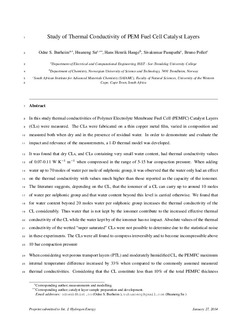| dc.contributor.author | Burheim, Odne Stokke | |
| dc.contributor.author | Aslan, M | |
| dc.contributor.author | Atchison, JS | |
| dc.contributor.author | Presser, V | |
| dc.date.accessioned | 2017-11-14T09:29:09Z | |
| dc.date.available | 2017-11-14T09:29:09Z | |
| dc.date.created | 2014-01-30T10:15:07Z | |
| dc.date.issued | 2014 | |
| dc.identifier.citation | Journal of Power Sources. 2014, 246 160-166. | nb_NO |
| dc.identifier.issn | 0378-7753 | |
| dc.identifier.uri | http://hdl.handle.net/11250/2466084 | |
| dc.description.abstract | The thermal conductivity of supercapacitor film electrodes composed of activated carbon (AC), AC with 15 mass% multi-walled carbon nanotubes (MWCNTs), AC with 15 mass% onion-like carbon (OLC), and only OLC, all mixed with polymer binder (polytetrafluoroethylene), has been measured. This was done for dry electrodes and after the electrodes have been saturated with an organic electrolyte (1 M tetraethylammonium–tetrafluoroborate in acetonitrile, TEA–BF4). The thermal conductivity data was implemented in a simple model of generation and transport of heat in a cylindrical cell supercapacitor systems. Dry electrodes showed a thermal conductivity in the range of 0.09–0.19 W K−1 m−1 and the electrodes soaked with an organic electrolyte yielded values for the thermal conductivity between 0.42 and 0.47 W K−1 m−1. It was seen that the values related strongly to the porosity of the carbon electrode materials. Modeling of the internal temperature profiles of a supercapacitor under conditions corresponding to extreme cycling demonstrated that only a moderate temperature gradient of several degrees Celsius can be expected and which depends on the ohmic resistance of the cell as well as the wetting of the electrode materials. | nb_NO |
| dc.language.iso | eng | nb_NO |
| dc.publisher | Elsevier | nb_NO |
| dc.title | Thermal conductivity and temperature profiles in carbon electrodes for supercapacitors | nb_NO |
| dc.type | Journal article | nb_NO |
| dc.description.version | submittedVersion | nb_NO |
| dc.source.pagenumber | 160-166 | nb_NO |
| dc.source.volume | 246 | nb_NO |
| dc.source.journal | Journal of Power Sources | nb_NO |
| dc.identifier.doi | 10.1016/j.jpowsour.2013.06.164 | |
| dc.identifier.cristin | 1104353 | |
| dc.description.localcode | This is a submitted manuscript of an article published by Elsevier Ltd in Journal of Power Sources, 25 July 2013. | nb_NO |
| cristin.unitcode | 194,64,25,0 | |
| cristin.unitcode | 194,66,25,0 | |
| cristin.unitname | Institutt for energi- og prosessteknikk | |
| cristin.unitname | Institutt for kjemi | |
| cristin.ispublished | true | |
| cristin.fulltext | preprint | |
| cristin.qualitycode | 1 | |
